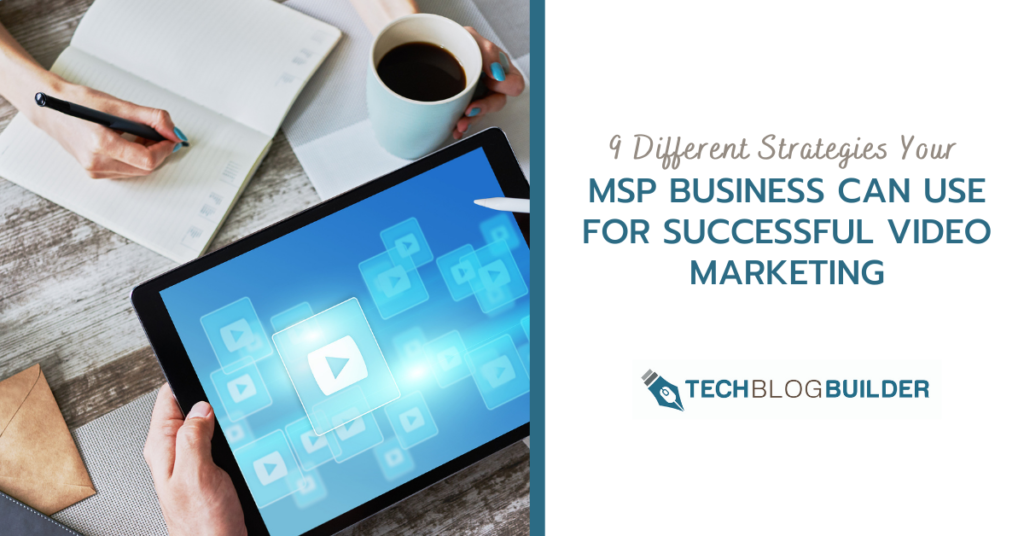Videos are taking over the internet and becoming a vital marketing channel for MSP providers and other small businesses.
People enjoy the engagement of videos and tend to retain the information better than if they read it. An explainer video can relay in 5 minutes of visuals what might take 45 minutes of reading.
The world of video marketing is not “one size fits all.” There are different strategies you can use for your videos that can help you reach people in different ways to get leads, convert sales, retain customers, and more.
Learn How to Use Different Video Types
Just as you have different types of content marketing designed to do different things (email, SEO, paid ads, etc.), video can also be used for different customer approaches.
For example, you might want to create a closer bond between your business and existing clients, so you do a “from the owner” video where you explain why you enjoy IT work.
In another video, you may want to introduce a new service, so you do an animated explainer video to help drive interest and leads.
Knowing how to use video in these varied ways can supercharge your video strategy with an important fuel for your tech marketing engine, and one that’s becoming essential.
Here are a few reasons to include these different video strategies in your marketing mix:
- 84% of people say a video has convinced them to buy a product or service.
- 66% of consumers would rather watch a short video than read about a product or service.
- 87% of video marketers say adding video brought more visitors to their website.
- 80% of businesses using videos to market say they’ve directly increased sales.
We’ll go through several of the most popular video strategies below and explain how you can use them to increase revenue at your IT business.
Topic-Based Video
A topic-based video is typically related to another piece of content marketing, such as your weekly, bi-weekly, or monthly blog posts.
These are short videos designed to keep clients engaged and cast a wide net to generate leads based upon multiple interests that a potential customer might have.
At Tech Blog Builder, we create videos based on blogs for clients to boost their message and marketing reach. This type of topic-based video can:
- Bring in leads from different interest areas (cybersecurity, Microsoft 365 users, etc.)
- Amplify the blog’s SEO strategy through outside links from social media & YouTube
- Keep fresh video content going out regularly
- Be used inside the blog to boost page views
People spend 2.6x more time on a webpage if it has a video on it.
Tutorial or “How To” Video
Tutorial videos are designed to help both you and your clients. They explain how something is done in an easy-to-understand way for people and can also lighten the load when it comes to answering common customer questions that tend to come in often.
For example, if you often get questions on how to find out if a device’s memory is upgradable, create a “how to” video on how to do this on different operating systems, and then use that link whenever asked about it in the future to save time.
“How To” videos are one of the most popular genres on YouTube. They are one of the top four content categories and are the only style of the four that isn’t entertainment related.
Animated Explainer Video
Animated explainer videos offer a cost-effective way to explain a product, service, or area of IT management. They’re generally fun and engaging for the viewer and can allow you to illustrate concepts that would not be as easy with a live-action video.
73% of people are more likely to buy a service or product when they see an explainer video about it.
You can use this style of animated video for sales (without coming off too “salesy”) and to help describe how certain processes work – like how your company’s managed IT services work behind the scenes.
If you need to relay detailed information in a way that’s easy to grasp, using animation in a video is often the way to do it successfully.
Face-to-Face Video
Another goal of video marketing is as a “get to know you” tool for relationship building. By opening up on a face-to-face video, you can make yourself and your MSP business more relatable to clients and future clients.
You’ll also help build trust. Potential customers will be much more likely to trust your business if they feel they know you through a video introduction. Current clients may be less likely to leave if they feel they have a connection with the owner of a business.
Ways that you can built trust using a face-to-face video is:
- Explain your company’s origin story
- Answer frequently asked customer questions
- Share your favorite tips and lessons learned related to IT
- Tell a humorous/personal story to make yourself relatable and memorable
Tour of Shop Video
Another type of “get to know us” video is doing a tour of your shop. Introducing your technicians as they’re in the midst of detailed IT work can also instill trust in a potential and existing customer.
74% of global consumers say they’ll continue to stay with a brand they trust, even if a trendier option becomes available. And 76% will recommend a company that they trust to others.

Tips for making a shop tour video:
- Keep the camera stable as you walk through your shop (otherwise, viewers could get motion sickness!)
- Clean up your shop before doing a walk-through
- Write out a plan with dialog in advance highlighting certain services
- Practice the walk through with your team first
- Enlist the help of a willing customer to play the “customer” role in the video
Presentation/Webinar Video
You should record all webinars and presentations that you give and add those videos to your marketing mix.
Webinar videos give those who couldn’t attend your webinar in person a way to still benefit from the content and give you the opportunity to offer a popular webinar “on-demand” anytime, without you needing to do them live all the time.
91% of B2B professionals say that webinars are their favorite form of video content.
Here are some tips for enriching webinars that can be captured and reused forever in video format:
- Do a Q & A at the end of a webinar
- Wednesday & Thursday are the most popular days to hold a webinar
- 11AM Pacific is when webinars have the highest attendance
- Keep it no longer than an hour (including the Q&A)
- Make a strong introduction and use a call to action at the end
Testimonial Video
Another type of video you can use to build up trust in your business is a testimonial video from one of your customers. Hearing how your technology services have directly helped another person, from that person, can be a compelling buying factor.
70% of customers are more than happy to give a testimonial for a business if they’re asked.
You can approach this in a few ways:
- Create one video per client story shot at the client’s or your location
- Do a compilation video with several customer quotes about your services
- Use shots of online reviews from Google, Yelp, or other sites
Using customer testimonials regularly in a marketing strategy can increase revenue by approximately 62%.
Sales Videos
You don’t want every video you make to do a hard sell to customers, but you should have some sales videos in your mix. They can be especially helpful on product landing pages.
Adding a video to a landing page can increase conversions by up to 80%.
Look for creative ways to show how a product or service is going to benefit a customer. When you’re doing a video about a service rather than a product, it can be more challenging, but if you focus on the ROI and benefit of the service to the customer, your video can help close a sale for you.
Here are some tips from Mediafast on how to make successful sales videos:
- Keep sales videos to 30-60 seconds in length
- Use humor or an interesting question to get attention right away
- Highlight pain points that your service/product solves
- Introduce and demonstrate your solution
- Provide social proof (i.e. 95% of our clients have been with us 10+ years)
- Use a call to action at the end (sign up now, etc.)
Live Stream Events
One of the newer forms of video marketing are live stream events. These can be done more informally, such as a weekly computer Q&A on Facebook Live or through doing a prescheduled event using live stream in a platform like Microsoft Teams, such as for a cybersecurity safety seminar.
The difference that live stream videos have is a feeling of community that people don’t quite get when they’re just watching a pre-recorded video.
For example, in a Facebook Live, people can see the emojis (likes, hearts, etc.) that are popping up as you speak and can also comment directly.
Live stream events can also be recorded for viewing later by those who couldn’t attend live.
Ideas for a live stream event:
- Special announcements about a new service or product (like a new branded VoIP service)
- Q&As with the audience on computer/IT related topics
- Interviews with others (such as interviewing a local insurance agent to discuss their take on cyber safety and cyber insurance)
- As a conference event (a virtual series of speakers & seminars)
Don’t Miss the Boat on Video Marketing!
85% of all internet users in the U.S. watch online video content every month. Don’t miss out on this vital marketing channel. Using a variety of video strategies can help you generate leads, convert sales, and keep customers loyal.
What’s your biggest challenge when it comes to video marketing? Let us know in the comments!


